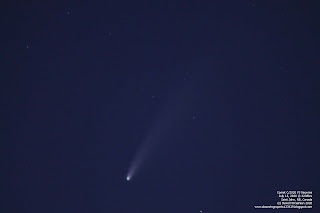Date Time: July 15, 2020 2230-2310hrs
Weather: Gusty winds from the NW, very cool, jacket weather, 13C, 61% humidity, party cloudy around the horizon, but mostly clear through rest of sky.
Equipment: Canon Rebel t3 with 18-55mm and 75-300mm lenses, 20x80 binoculars.
Attendance: Brandon, Ed from his place, and Myself.
Objective: To view and image Comet C/2020 F3 Neowise, which as moved into the evening sky and is now circumpolar.
Report:
- Weather forecast was calling for mostly cloudy skies. We have had almost a month straight of foggy/cloudy weather, at night, with very few, short breaks, in places. This has made viewing and imaging this spectacular comet very difficult up to now. Surprisingly, according to Ed, a few hours before dark, a cool, north west wind blew through. This cleared out what was going to be another cloudy/foggy night.
- Went out around 2230 hrs to look for comet, which was supposed to be in the NNW sky. After a short, naked eye scan of the low northern sky, Comet Neowise popped out easily, under the Big Dipper with it's 2 degree tail pointing in the approx. 1:30 position. This tail direction was very different from the morning viewing of the comet on July 10, 2020, where the tail was pointing almost straight up in the 12:00 direction. Nucleus is very bright, while the tail is much dimmmer, but very see-able. Wasn't completely dark until almost 2300 hrs. Comet was spectacular in binoculars! It took up at least a half of the field of view! Very bright central region, with striations of brightness through the tail. Naked eye, the darker the sky got, around 2300hrs, the comet became very easy to see, even in all the light pollution from the City. A truly wonderful thing to see!
 |
| Single shot, taken at 2238 hrs, 4 sec, f/5.6, 300mm, ISO 800. |
 | |
| Saint John River, Ocean Steel and the NB Museum on Douglas Ave seen in the foreground. Single shot, taken at 2232 hrs, 3 sec, f/5.6, 55mm, ISO 800. |
- Saturn and Venus were very bright, close together and low in the southern sky during this time.
 |
| Single shot, image taken at 2040 hrs, 4 sec, f/5.6, 130mm, ISO 800. |
- No satellites or shooting stars were seen.







